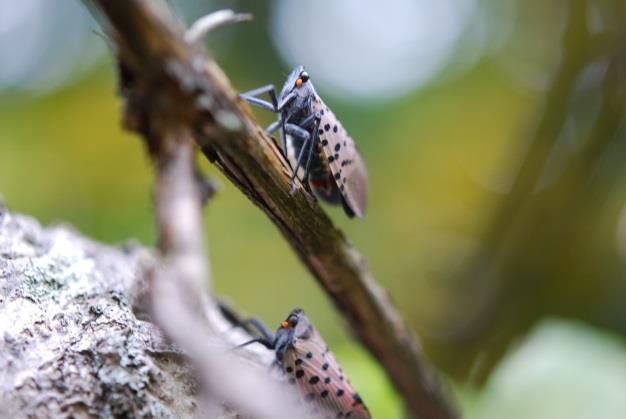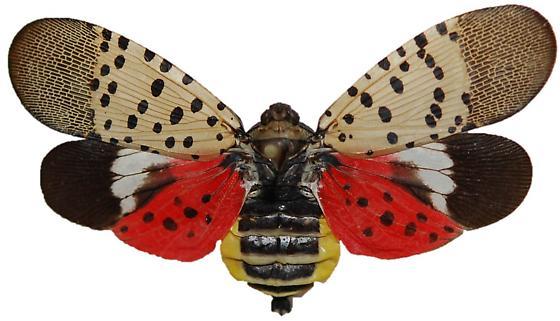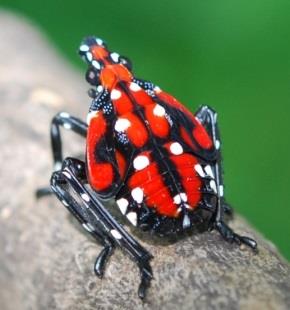Pest Alert: Spotted Lanternfly

- Common Name: Spotted Lanternfly
- Order: Hemiptera
- Family: Fulgoridae
- Scientific Name: Lycorma delicatula (White)
Spotted lanternfly (SLF) is an invasive plant hopper native to China, India, and Vietnam. It has been introduced in Japan, South Korea, and, closer to home, Pennsylvania. In Korea, where it was first detected in 2004, it is known to feed on over 70 plant species and is a pest of both grapes and peaches. The first detection for the U.S. was confirmed in Pennsylvania in September 2014. SLF most likely arrived as egg masses on an imported product or shipping material from China up to two years earlier. As of February 2016, SLF has been detected in 6 counties, with its range steadily expanding. SLF is a highly invasive insect that can spread rapidly when introduced to new areas. Insects seem to spread by hitchhiking. This pest has the potential to greatly impact the grape, tree fruit, plant nursery and timber industries in the U.S.

Barringer, BugGuide Copyright © 2014.
Appearance: Adult SLF are ~1” long and ½” wide when resting. The forewings are light brown to grey with black spots and the wing tips are reticulated black blocks outlined in grey. The hindwings are red with black spots with a white band separating the tips of reticulated black blocks. The head and legs are black, while the abdomen is yellow with broad black bands. When resting, adults fold their wings in a tent-like position over the body and appear light brown to grey with black spots. Adult females can be distinguished by the presence of a red spot at the tip of the abdomen. SLF eggs are laid in masses containing 30-50 eggs. Egg masses are 1-1.5” long and ½ – ¾” wide, greyish-brown, and covered with a grey, waxy coating. First stage immatures are wingless and black with white spots. As the nymphs grow to the last instar, they will develop red patches while keeping the white spot pattern.

Host Range: As they emerge, nymphs will disperse from the egg mass site by crawling or jumping, and appear to feed on a wide range of plant species, feeding on almost every plant they encounter on the ground. The new hosts will include several kinds of agricultural crops such as grape and fruit trees. Nymphs are most often observed on leaves and branches of plants. Nymphs and adults tend to aggregate in large numbers on host plants. In the fall, adult SLF will aggregate in groups on tree of heaven (Ailanthus altissima) (F.), willows (Salix spp.), and other trees. Tree of Heaven, also known as Paradise tree, is a preferred host for adults in the fall as a food source, mating and egg laying site. Tree of Heaven is an invasive species native to China and is a fast growing deciduous tree often found in disturbed sites or along roadways. Other hosts include maples (Acer spp.), birch (Betula spp.), poplars (Populus spp.), tulip trees (Liriodendron spp.), ash (Fraxinus spp.), oak (Quercus spp.), grape (Vitis spp.), and tree fruits, such as apple and stone fruits.

Symptoms and Effects: SLF adults and nymphs feed on the plant’s phloem, sucking the sap from young stems and leaves. Affected trees will show weeping or oozing wounds of sap on the trunks, leaving greyish-black trails along the trunk. Damage can result in the withering of whole trees; as photosynthesis is reduced, the trees will weaken and may eventually die. In addition, SLF excrete large amounts of honeydew, a sugar-rich liquid as they feed on large amounts of plant sap. In heavy SLF infestations, the honeydew secretions will cover the stems and leaves of trees, and will build up on the ground at the base of the plant. The secretions will in turn get colonized by sooty mold fungal growth which can also reduce photosynthesis and eventually lead to plant death. Honeydew secretions and sap-oozing plant wounds will attract other insects such as wasps, hornets, bees, and ants. When larger populations of SLF are found nearby, fruit trees and grapes may be more susceptible to damage and mortality.
Life Cycle: SLF is univoltine, meaning that it has only one generation per year, and overwinters as eggs. In the spring and early summer, the eggs will hatch and undergo four nymphal instars. Adults will begin to appear in July with abundant populations in August. Males and females mate multiple times and female may lay eggs twice before dying (based on observations in South Korea). Egg laying begins in September and continues through November, until all adults die with the onset of winter. Egg masses are laid on smooth bark of medium to large trees, on trunk, branches, and limb bases, but also on stone or other vertical surfaces.

Monitoring and Control: SLF adults are poor fliers but very strong jumpers and thus prefer to walk. Nymphs and adults congregate in large number on host plants and are easy to see at dusk or night when they migrate up and down tree trunks. They are harder to see during the day as they tend to stay near the base of the host plant. Beginning in late April to mid-May, nymphs may be seen on smaller plants and vines, and any new growth on trees and shrubs. Adults should be monitored in late August-September. Mating and oviposition will occur from evening to night from mid-September to November. Look for egg masses from October into spring predominantly on tree of heaven, but not exclusively. Egg masses are often inconspicuous and may be found on outdoors manmade items such as vehicles, yard furniture, and farm equipment. Thus, egg masses may pose the greatest risk for hitchhiking to new areas. Immature stages are easily caught on sticky tree bands as they actively crawl up and down trees and plants. Adult and late instars are not often caught on these bands.
Quarantine and Status: An active monitoring and eradication program is underway in Pennsylvania to prevent the spread of this new invasive pest. For more information about this insect, visit www.agriculture.pa.gov/Protect/PlantIndustry/spotted_lanternfly/. To this date, SLF has only been confirmed in eastern Pennsylvania in six counties, which are under quarantine. Because SLF is spreading steadily and has the potential to affect the grape, tree fruit, tree and wood-product, and green industries, it is important to be on the lookout for possible detections and infestations in Wisconsin. If you suspect insects you see might be SLF, please contact the Insect Diagnostic Lab in the Entomology Department at UW-Madison (http://labs.russell.wisc.edu/insectlab/contact-us/).
This article was posted in Insects, WFN, Vol. 1-4 and tagged Christelle Guédot, insects, spotted lanternfly.
